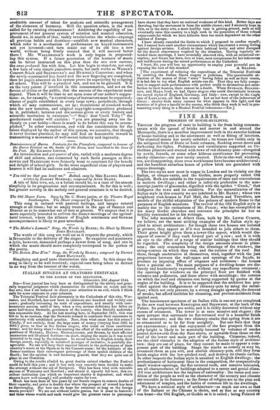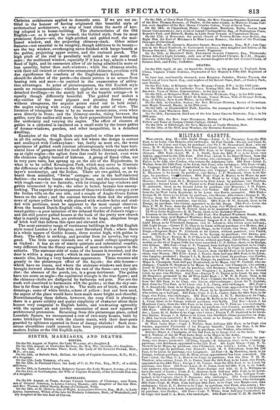FINE ARTS.
PROGRESS OF HOUSE-BUILDING.
THOUGH the progress of taste in building is far from being commen- surate with the spread of bricks and mortar in and around the
Metropolis, there is a manifest improvement both in the exterior fashion of house-building and in the adornment as well as fitting of interiors. The classical mania has nearly subsided ; its traces are visible only in the mitigated form of Doric or Ionic columns, flanking street-doors and darkening fan-lights. Pediments and entablatures supported on Co- rinthian pilasters and crested with rows of red chimney-pots—elongated
by cowls' funnels, or some other hideous contrivance for preventing smoky chimnies—are now rarely erected. Hole-in-the-wall windows, too, are disappearing, since even workhouses have become architectural ; and the humblest suburban boxes of yellow brick are garnished with stucco dressings.
The two styles now most in vogue in London and its vicinity are the Italian, or cinque-cento, and the Gothic, more properly called Old English. Both are suitable to the requirements of taste and convenience in modern dwellings ; and either is infinitely preferable to the non- descript jumble of gimcracks, dignified with the epithet " Greek," that disfigures the town and its outskirts. For the naturalization of the
Italian style in this country we are indebted to Mr. BARRY; whose two neighbour club-houses in Pall Mall, the Reform and Travellers, are- models of the skilful adaptation of the palaces of modern Rome to the purposes of English mansions. The revival of the Old English style is mainly due to the enthusiasm of Mr. Pocns ; who has exemplified in his many Gothic churches and convents the principles he has 80 forcibly contended for in his writings. The lofty mansions at Albert Gate, built by Mr. LEWIS CUBITT, we believe, are the most striking examples of the Italian style ap-
plied to street architecture : for though these two houses are isolated at present, they appear as if it was intended to join others to them, Their great height gives them a tower-like aspect, which would dis- appear of course if they each formed part of a row ; and it is with an eye to the effect of a range of similar buildings that they should be regarded. The simplicity of the design amounts almost to plain. ness ; the only ornaments being the dressings of the windows, the
string-courses on which they rest, and the cornice of the roof. But these, though unobtrusive in themselves, tend, together with the just proportions between the wall-space and openings of the façade, to
produce an imposing effect of elegance and nobleness : the houses have a palatial air. The main purposes of a dwelling-house are dis- tinctly and handsomely expressed, without any superfluous ornament : the openings for windows on the principal floor are finished with columns and pediments, and those above with mouldings ; the cornice on which the roof and chimnies rest being supported by quoins at the angles of the building. It is to be supposed that the architect has pro- vided against the disfigurement of chimney-pots by using the metal- flues ; which not only prevent, by a strong draught upwards, the descent of smoke, but afford facilities for cleansing, and prevent accidents from ignited soot.
The handsomest specimen of an Italian villa is one not yet completed. in the new road between Kensington and Bayswater, at the back of the
Palace. Its proportions are noble, and it is richly decorated without any excess of ornament. The tower is at once massive and elegant : the- open parapet that surrounds its flat-terraced roof is a beautiful finish to the structure; and the two chimney-stacks that spring from it are so ornamental as to be far from unsightly. But one feels that they are excrescences ; and that enjoyment of the fine prospect from the lofty height is likely to be materially lessened by volumes of smoke poured downwards from the flues above or upwards from those on the roof of the lower and main part of the building. Chimnies, indeed, are the chief obstacles to the adoption of the Italian style of architec- ture: they are out of place, for they cannot be made to appear a com- ponent part of the building. Shape the stacks as comely as may be,
ornament them as you will, and abolish chimney-pots, still they form harsh angles with the low-pitched roof, and destroy its classic outline. ICI other respects the Italian style is unsuited to English dwellings : the predominance of horizontal lines in the composition, the comparatively small window-openings, the flat-terraced roofs, and massive balconies, are all characteristics of buildings adapted to a sunny and genial clime. All true architecture has the impress of nationality : the tastes and con- dition of the people as well as the character of the scenery and climate are traceable in its features ; as the forms of religion are in the plan and, adornment of temples, and the habits of common life in the dwellings.
We have a national style of architecture—as much our own as that of the Italians or the Chinese is theirs, and as fine as any country can boast—the Old English, or Gothic as it is called ; being Pointed or
Christian architecture applied to domestic uses. If we are not en- titled to the honour of having originated this beautiful style of ecclesiastical architecture, we may at least claim the merit of hav- ing adapted it to house-building. The characteristics of the Old English—or, as it might be termed, the Gabled style, from its most
roominent feature—are, the high-pitched and gabled roof, the mul- 'ned window, and the projecting chimney-stack. Other minor features—not essential to its integrity, though additions to its beauty— are the bay window, overhanging eaves finished with barge-boards at the gables, projecting upper stories, and the enclosed porch. The high pitch of the roof is peculiarly well suited to our moist cli- mate; the mullioned window, especially if it has a bay, admits a broad flood of light, and its casements allow of air being admitted in more or less quantity, better than sash-windows ; while the chimney-stacks, with their tall twisted or otherwise ornamented chimnies, proclaim with due significance the comforts of the Englishman's fireside. Nor should the shelter of the porch—the classic portico is no screen from beating rain and snow—be omitted in the enumeration of utilita- rian advantages. In point of picturesqueness, the Old English style needs no recommendation : whether applied to street architecture or detached dwellings—to the stately hall or the humble cottage—it is equally though differently beautiful. The gabled roof snakes a sky-outline of the most piquant and pleasing forms : sharp 'without abruptness, the angular points stand out in bold relief; the angles varying with every change of the point of view. The iteration of triangular forms is by no means monotonous, even when seen directly in front; and the chimney-stacks, rising between the gables, vary the outline still more, by their perpendicular lines breaking the uniformity and varying the angles. The effect of clusters of gables in a cathedral is emulated on a small scale by the lesser gables of dormer-windows, porches, and other inequalities, in a detached Examples of the Old English style applied to villas are numerous in all the suburbs, though there are few where the design is correct and unalloyed with Cockneyisms : but, faulty as most are, the worst specimens of gabled roofs contrast advantageously with the bare hori- zontal lines of parapets and flat roofs from which chimney-stacks stick up at right angles—the ugliest form that could be devised, even were the chimnies sightly instead of hideous. A group of fancy villas, not in very pure taste, has sprung up on the site of the Hippodrome, in 'what is to be called Kensington Park, which may serve to illustrate the difference of effect between the Old English, the modern, or brick- layer's nondescript, end the Italian. There are two gabled, or, as we heard them miscalled, "Swiss" cottages : one in the half-timbered fashion—the wooden beams showing in front, and the interstices filled with rough-cast—is too fantastic, with its triangular bay- windows and gables intersected by walls ; the other is better, because less uneasy- looking. The superior picturesqueness of these two Gothic cottages over the Italian villa on the one side, and a couple of Anglo-Greco Italian boxes on the other ; and the contrast between them and the adjacent rows of spruce yellow brick walls pierced with window-holes and stud- ded with porticoes, must be apparent to the most casual observer. Even the bastard Dutch-English villa, with its conical spire and flat- tened gables—a poor imitation of the debased Gothic of James's reign— and the still poorer gabled houses at the back of the pretty new church that is rapidly rising here, are preferable to the huge, shapeless heaps of brick wall that deform this open and elevated site.
The most extensive range of continuous buildings in the Old English style round London is at Islington, near Barnsbury Park ; where there is a whole square of Gothic houses, three stories high, with gables in front. The effect is striking, and peculiar from its novelty, but very good. The little square reminds one of a small college-quadrangle at Oxford : it has an air of stately quietude and substantial comfort, very different from the flimsy smugness of most modern squares in the suburbs. The staircase-side of some of the houses is recessed, and the door is within a snug porch ; which in one instance is paved with en- -caustic tiles, having a very handsome appearance. These recesses add greatly to the picturesque effect of the façade : the side-houses- which have no recess, and where the staircase-windows and door are brought forward almost flush with the rest of the front—are very infe- rior: the absence of the porch, too, is a great detriment. The gables have too acute an angle—the equilateral triangle is the true figure ; and the chimney-shafts are disfigured by barbarous red pots. Nor are the roofs well contrived to harmonize with the gables ; so that the sky-out- line is far from what it ought to be. The walls are of brick, with stone dressings; some of white bricks, others of yellow : bad red been used, the aspect of the place would have been much more bright and cheerful. Notwithstanding these defects, however, the coup d'ceil is pleasing: there is a grave solidity and quaint simplicity of character about these houses very congenial to English habits, and contrasting agreeably with the upstart air and tawdry ostentation of most new squares of architectural pretension. Returning from this picturesque place, called Lonsdale Square, we encountered a row of two-story houses, built by some bricklayer bitten with the classic mania, with their door-posts guarded by sphinxes squatted in front of dumpy obelisks ! Such mon- strous absurdities could scarcely have been perpetrated either in the modern Italian or the Old English style.



























 Previous page
Previous page